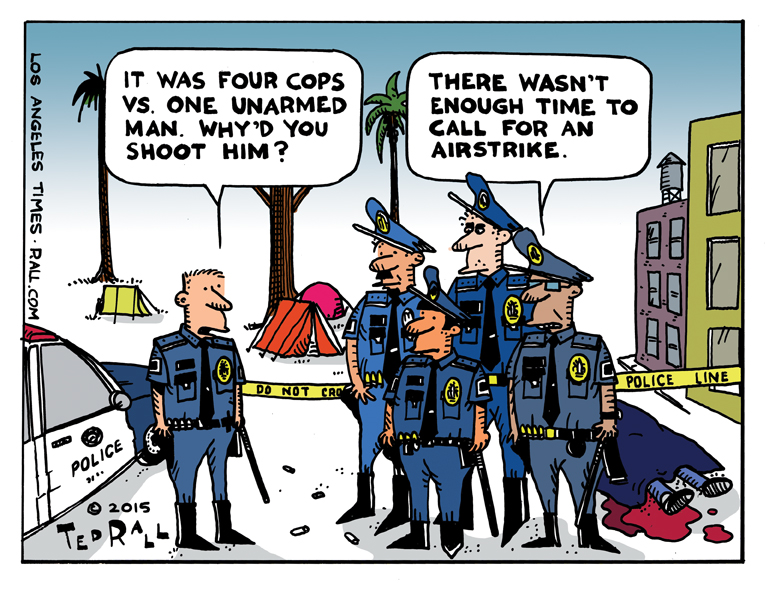Originally published by The Los Angeles Times:
The police shooting of a 39-year-old homeless man in the skid row section of downtown Los Angeles is prompting comparisons and reactions familiar to those that followed police killings of unarmed black men in Ferguson, Mo., and New York. The identity of the man is still not clear, but he was known as “Africa” to some who knew him on the streets.
The incident is still under investigation but many question how dangerous a man without a gun can be to four highly trained law enforcement professionals, all armed. The LAPD says its officers first approached Africa in response to a robbery call, and that its officers shot the man to prevent him from taking one of the officers’ guns. The revelation that Africa was a convicted bank robber who served a long prison term seems to bolster the image of a dangerous person. In Ferguson, police also pointed to the victim’s alleged involvement in a robbery.
Then there’s the context of lousy community relations. “Skid row has been home to police occupation under the Safer Cities Initiative,” Steve Diaz, an organizer for the Los Angeles Community Action Network, said at a meeting of the Los Angeles Police Commission’s weekly meeting. “They clear people out in the name of gentrification.”
Since at least one of the LAPD officers was wearing a body camera, the investigation is also being viewed as a test case for a technology that advocates hope will hold rogue cops accountable and defend honest ones against folks’ charges of brutality. The claim of a St. Louis man that a policeman turned off his dashboard cam before beating him, following a similar story in New Orleans late last year, has skeptics wondering whether videotaping really is a solution in such cases.
Maybe it’s because I’m old enough to remember domestic policing before it was militarized and excessive force became the norm, but for me this is as much a story about officers who escalate violence far too quickly as it is about other relevant issues, such as racism.
Writing about Michael Brown, the man killed in Ferguson, a letter writer to the Wall Street Journal noted: “It is unacceptable that Officer Darren Wilson had access to a Taser and intentionally didn’t carry it. We will never know whether a Taser would have de-escalated the encounter between Officer Wilson and Michael Brown, and prevented Mr. Brown’s death.”
What should be something from Kindergarten Cop 101 has gotten lost in many cases: Police should do everything they can to avoid violence in the first place. Then, if a peaceful resolution isn’t possible, force should be escalated gradually. That did not appear to be what happened in Brown’s case. And Tamir Rice, the 12-year-old Cleveland boy shot to death two seconds after a rookie officer got out of his police car, didn’t appear to have a chance to cooperate or surrender. Akai Gurley, 28, was killed by a bullet fired by a nervous NYPD officer who heard a noise in the dark stairwell of a housing project.
You can’t blame police officers for being scared when they confront possible suspects. But it’s fair to expect proportionality based on, first of all, the alleged offense. It’s hard to tell from the video in the L.A. case, but there is reason to suspect that this incident moved from confrontation to physical engagement way too quickly. Then there’s the proportionality of physical force: You’ve got four armed officers taking on an unarmed man. Frankly, if they don’t have what it takes to keep the guy down, they need to go back to the police academy.


2 Comments.
BANG!
BANG!
“Stop, or I’ll shoot!”
> Since at least one of the LAPD officers was wearing a body camera,
I don’t like it, but I consider it the lesser of evils. It’s obvious that we have to reign in our out-of-control police – a few more of these caught-on-tape incidents and maybe … just maybe … we can start on it.
I’m older than Ted, and I *can’t* remember a time when the police didn’t abuse their power. Growing up in a rural area with a pony tail and an attitude might have contributed to those memories. Remember, the beat down in Selma was in 1965. The police were used in union-busting in the late nineteenth century and early twentieth. They didn’t have any problem killing people back then, nor beating them down with their clubs. click here and search for the word “Police.”
Which isn’t to say it isn’t getting worse – it most certainly is. Just to say it’s not a new thing. But if we’d shut ’em down decades ago, we’d have fewer problems today.
Crazy H is right. It’s the JOB of the police to shoot black people, and poor people, and union demonstrators, and anyone those who own the country think might cause trouble. It’s not that there aren’t nice police officers, some of whom might have been around when Ted was growing up, where he was growing up. When I was a teenager (I’m two years older than Ted) in a ritzy area on Long Island (where I didn’t really fit in, my dad was a guidance counselor in the NYC public schools, my parents got very very lucky when they bought their house) the cops were very nice to us local kids, not so much to anyone else. We won’t shut the police down until we shut the society down.